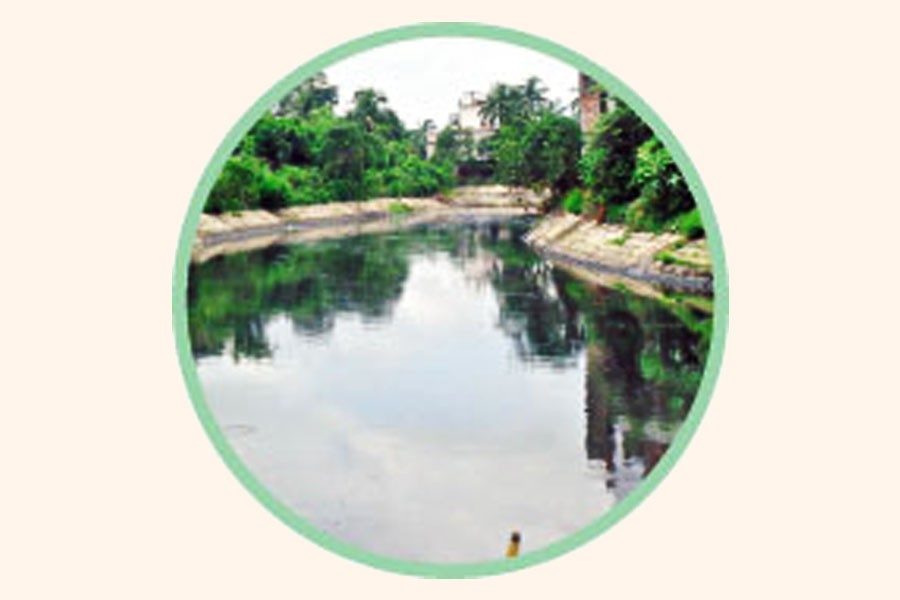
Published :
Updated :

It is more than a year, the two city corporations were entrusted with the responsibility of reclaiming the canals and water bodies in and around the capital from the grabbers and making them pollution-free. The Dhaka North City Corporation (DNCC) and the Dhaka South City Corporation (DSCC) took charge of 26 canals on December 31, 2020 from the Dhaka Water Supply and Sewerage Authority (WASA) with the objective of evicting illegal grabbers and removing waste to ease the flow of water.
The major canals under the DSCC include Segunbagicha-Arambagh, Khilgaon-Basabo, Manda, Jirani, Hazaribagh, Katasur and Dholaikhal, according to official sources. The canals under the DNCC include Diabari, Badda-Shahjadpur, Kasaibari, Kalyanpur main canal and its branches, Rupnagar, Sangbadik Colony, Baunia, Baishteki, Ramchandrapur and Sutikhola. The two authorities, however, cleaned the surface water of a few canals and demolished only a small number of illegal establishments. In some cases demarcation of boundaries of a few canals was also done. But what so far has been done does not at all seem meaningful. In fact, the state of the canals has remained the same. More so, nothing is yet in sight to get back some the canals that are partially or entirely lost. It now appears difficult to say how many canals crisscrossed the capital once upon a time, and how many are still there.
The sorry state of Dhaka's canals has for long been a subject of news stories -- not just as a manmade havoc on environment but more pathetically as a monstrous act causing water-logging and pollution of all sorts.
The government has over the years carried out studies one after another, worked out master plans, even named some big grabbers and resolved to reclaim the occupied canals and lands alongside them. But nothing tangible has happened as agencies responsible for the management of the canals have themselves grabbed land, allowing private entities to step in, and remained silent about others occupying the canals and lands. There are a number of laws such the Canals Act 1864, the State Acquisition and Tenancy Act 1950, the Open Space and Wetland Conservation Act 2000 and the Bangladesh Environment Conservation (Amendment) Act 2010. Yet, the occupation and grabbing have continued.
Years ago, there was a move on the part of the concerned authorities to spend Tk 50 billion to excavate new canals in the northern part of the capital. While the project did sound holy enough to inspire hope of relieving some parts of Dhaka of the terrible water-logging during the monsoon, there was little or no action regarding the lost and dying canals. No matter how useful the new canals might have proved to be, what bothered the country's urban experts was the lack of interest of relevant authorities to recover the lost and about-to-be-lost canals. We have been hearing about steps, even stern steps to address the situation from successive governments, but nothing is in sight as of now.
In the past thirty years or so, around forty canals have either totally disappeared in and around Dhaka, while some have turned into tiny muddy trickles. A daily newspaper reports that 39 canals have totally disappeared. Those that are still alive are mostly in the grip of influential quarters. On the other hand, unplanned urbanisation has led to the building of box culverts over the canals, an act believed to be instrumental in killing the vital arteries of the capital.
According to the Dhaka WASA, until 1985, the capital had 54 canals and most of those were interlinked heading towards the four rivers around the city. It is not at all difficult to detect how most of them got lost or buried and the nature of hindrance that caused them so. All it takes, according to the experts, is political will. Renowned urban expert Professor Nazrul Islam commented that the only way to recover the lost canals and maintain them is through strict enforcement of law. Professor Ainun Nishat, noted environmentalist, in an interview with a local daily some time ago, commented that tracing the routes of the canals can easily be done from documents, including the length and breadth of each and every canal. The Dhaka district administration could play a lead role in this.
Besides grabbing of canals and nearby lands, building of box culverts on a number of important canals in the central part of the capital is considered an urban faux pas by most urban experts. These box culverts on as many as twelve important canals with funding from the World Bank, Asian Development Bank and Japan International Cooperation Agency were made in 1989, with provision for roads above them. But as it now appears, while undertaking the project the issue of maintaining clearance in the drainage channels under the culverts was not heeded to, which has become a major concern due to blockage causing water-logging.
Against this backdrop, the decision to engage the city corporations with full authority to restore the canals to their original state and maintain them seemed to promise quick action. Urban planners say the city corporations should make a mid-term and long-term plan prioritising the eviction of canal grabbers, and as a starter they should make the boundary demarcation for a permanent solution to the problem and need to improve the waste management system, including household and commercial waste to protect the canals. Will the city corporations rise up to the occasion?
wasiahmed.bd@gmail.com


 For all latest news, follow The Financial Express Google News channel.
For all latest news, follow The Financial Express Google News channel.